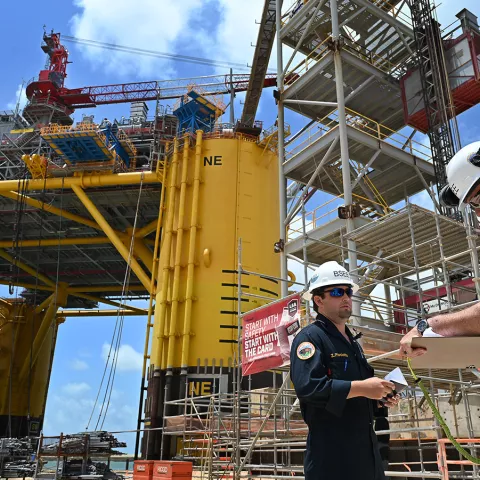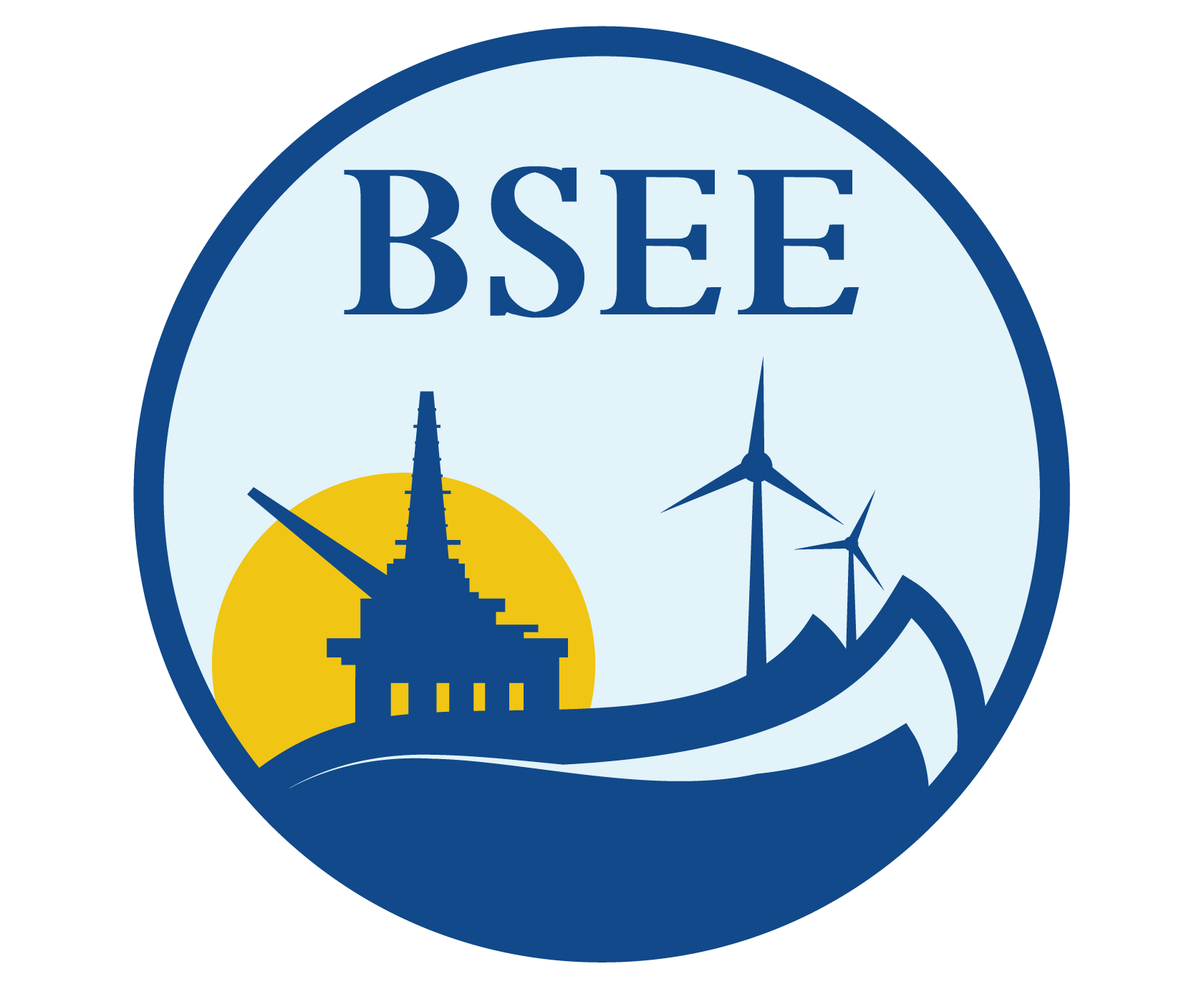
Since its establishment in 2011, BSEE has been the nation’s lead agency charged with improving safety and ensuring environmental protection related to the oil and natural gas industry on the U.S. Outer Continental Shelf. Central to BSEE’s mission is the continuous improvement of its regulatory functions involving worker safety, emergency preparedness, environmental compliance, and conservation of resources. The Bureau’s efforts extend from the development of improved technologies to the inspection and regulation of offshore facilities to responses when safety or environmental incidents occur.
Comprising 1.76 billion acres of seafloor, the OCS, may still hold technically recoverable undiscovered fields containing as much as 90 billion barrels of oil and 327 trillion cubic feet of natural gas. Extracting these resources requires the talents of a highly specialized workforce and equipment that is often state-of-the-art. Complicating these efforts are the remoteness of offshore platforms and uncertainties of both weather and subsea operations. Layered throughout these factors are the consequences of missteps that can result in oil spills, gas releases, injuries, and even fatalities.
To carry out its responsibilities, BSEE seeks to continuously improve its ability to properly regulate offshore oil and gas operations, enhance the safety of offshore energy exploration and production, ensure the protection of the environment and promote the implementation of the latest technological advancements.
BSEE’s hybrid approach to regulation employs both prescriptive-and performance-based methods to help ensure the safest operations possible. The regulations BSEE enforces typically incorporate widely-accepted industry standards and best practices. BSEE conducts on-site inspections to ensure compliance with regulations, lease terms and approved plans. On an annual basis, BSEE conducts approximately 20,000 component inspections for more than 2,000 facilities in Gulf of America, Pacific and Alaskan waters.
With innovative regulatory approaches and appropriate collaboration with industry, BSEE is fostering an offshore safety culture that reduces the risk of incidents and spills, while enhancing its ability to prepare and respond to those that do occur with prompt and appropriate actions. The U.S. OCS provides the raw material for a substantial amount of our nation’s energy needs, but it will always be a difficult and sensitive environment in which to operate. BSEE understands that its jurisdictional role fulfills a critical national function: regulation of the offshore oil and gas exploration and production industry in order to reduce risks for workers, protect the environment, and ensure maximum ultimate recovery − and minimize waste − of America’s vast offshore energy resources.
Downhole Commingling (DHC)
Frequently Asked Questions (FAQs)
Downhole commingling (DHC) is a method used in offshore oil production where hydrocarbons from multiple underground reservoirs are combined and produced through a single wellbore. This approach increases efficiency, optimizes recovery, and reduces operational costs.
By enabling production from multiple reservoirs through a single well, DHC minimizes the number of wells needed, reducing costs, infrastructure footprint, and accelerating timelines for bringing oil to market.
Commingled production significantly enhances overall oil recovery, as demonstrated by recent studies, allowing operators to maximize the potential output from each well.
BSEE updated its guidelines to allow a pressure differential of up to 1500 psi between commingled reservoirs, expanding opportunities for efficient resource development, particularly in the Wilcox formations.
Increasing the pressure differential limit provides operators with greater flexibility to commingle zones which may have, in some cases, required separate wells, leading to enhanced production and cost savings.
Pressure differential refers to the difference in pressure between two reservoir zones that are produced together in one well. If one zone has a much higher pressure than another, fluids can crossflow from the high-pressure zone into the low-pressure zone instead of flowing up to the surface. This unwanted internal flow wastes reservoir energy and can reduce overall oil recovery. BSEE has been cautious about commingling zones with large pressure differences for this reason.
Crossflow is when fluid flows from one reservoir zone into another within the well, rather than up the well to the surface. It usually happens when two commingled zones have different pressures – the higher-pressure zone can push oil or gas into the lower-pressure zone. Crossflow is undesirable because it means some oil or gas isn’t being produced to the surface; instead, it’s just moving between zones and effectively getting stuck or even causing problems. Overall, crossflow can lead to a loss of recoverable reserves from one or both reservoirs. When crossflow is avoided, each reservoir can produce to its full potential without one robbing or suppressing out the other.
The updated policy is based on findings from a University of Texas study and collaboration with industry experts, highlighting that safe commingling with larger pressure differentials can significantly boost recovery without compromising reservoir integrity.
This change, the result of extensive technical consultation with offshore industry leaders, could increase production output by roughly 10%, which would translate into over 100,000 barrels per day production increase over the next ten years. Additional gains are possible as operators provide further data. Results from a University of Texas study on commingling show that commingled production maximizes per-well oil production compared to sequential schemes. Over 30 years, it could potentially provide 61% more oil recovery.
By lowering development costs and increasing production efficiency, the policy encourages investment, supports job creation, and strengthens the offshore energy sector.
Improved efficiency and lower operational costs translate into more affordable energy for consumers, contributing to long-term price stability.
Commingling reduces the need for additional drilling infrastructure, minimizing the environmental footprint of offshore operations and promoting responsible resource management.
Operators must comply with strict requirements for monitoring, fluid compatibility certification, and maintaining well integrity to ensure operations are conducted safely and responsibly.
Fluid compatibility means making sure the oil, gas, and formation water from different reservoirs can mix without causing problems. This is critical because incompatible fluids can foul the well or surface equipment, sharply reducing flow and requiring costly interventions. BSEE requires operators to ensure compatibility of reservoir fluids before commingling. In practice, if tests show that fluids are incompatible, operators might use chemical additives or decide not to commingle those zones. In summary, fluid compatibility is all about flow assurance – making sure that when the different reservoir fluids mix, they will safely produce through the well and facilities without any surprises that could damage equipment or block the flow.
Operators must demonstrate that commingling will not compromise reservoir performance, confirm fluid compatibility, and maintain flowing pressures below the lowest reservoir pressure.
BSEE requires regular performance reporting, pressure monitoring, and may mandate recurring reviews to verify ongoing compliance and reservoir management effectiveness.
Deepwater Paleogene (Wilcox) reservoirs particularly benefit from the new commingling guidelines, given their complex geologic characteristics and high development costs.
Studies show commingling can yield up to 61% more oil over a 30-year period compared to sequential production approaches.
These terms describe two ways of producing oil from multiple stacked reservoirs in one well. Sequential production means you produce one zone at a time (usually starting with the deepest zone and then moving upward). The zones are kept isolated, and you only open the next zone after the previous one has reached its economic limit. Commingled production, on the other hand, means you produce from two or more zones simultaneously through the same wellbore.
Yes, modern offshore infrastructure, equipped with intelligent completions and advanced monitoring technologies, can manage the increased pressures safely.
Intelligent completions (often called smart wells) are advanced well designs that include downhole sensors and remotely controlled valves for each production zone. They provide real-time data (pressure, temperature, flow rates) from each reservoir layer and let engineers adjust or even shut off flow from individual zones without needing a rig on site. This is coupled with zonal isolation tools – like packers and sliding sleeves – that keep the zones physically separated inside the well so that fluids only commingle in a controlled way.
By removing unnecessary barriers, the updated policy promotes innovation, supports operational efficiency, and helps unlock previously untapped production potential.
Yes, operators must still seek BSEE approval for downhole commingling requests, ensuring each project meets stringent safety and environmental standards.
Increased production activity supports high-paying jobs in offshore operations, engineering, supply chains, and support industries.
Higher domestic production strengthens the reliability of the nation’s energy supply, reducing dependency on foreign sources.
While effects may be gradual, increased efficiency and output from offshore operations contribute to greater energy market stability, helping to moderate long-term consumer costs.
Yes, BSEE remains committed to evaluating operational data and incorporating lessons learned to further refine and improve commingling practices.
Data will guide continuous improvements in regulatory frameworks, promote best practices, and ensure that environmental protection and resource conservation remain priorities.


